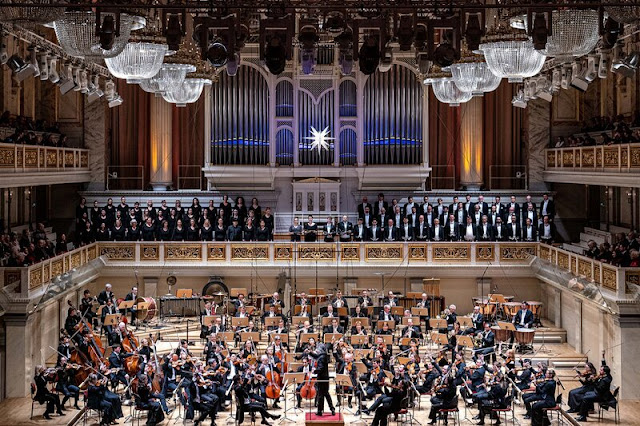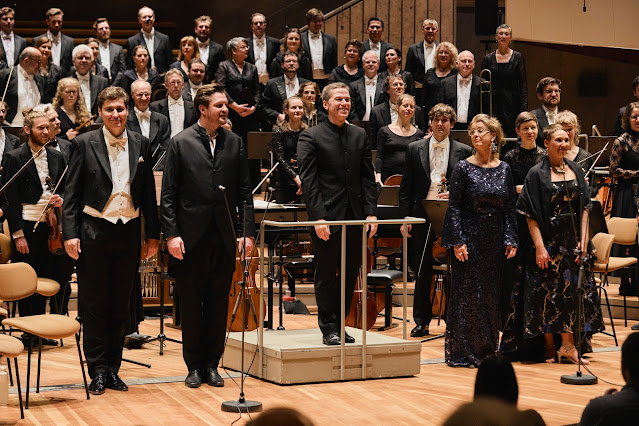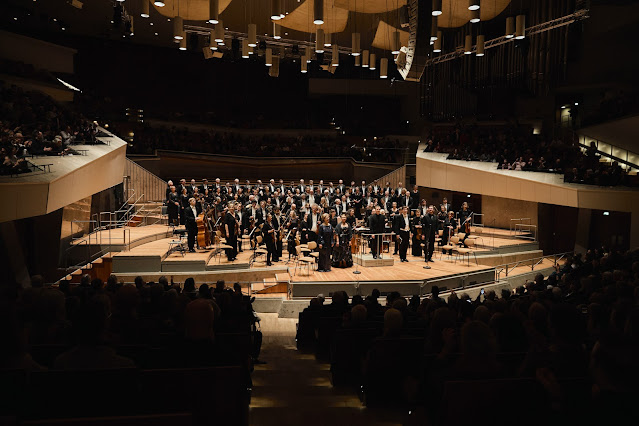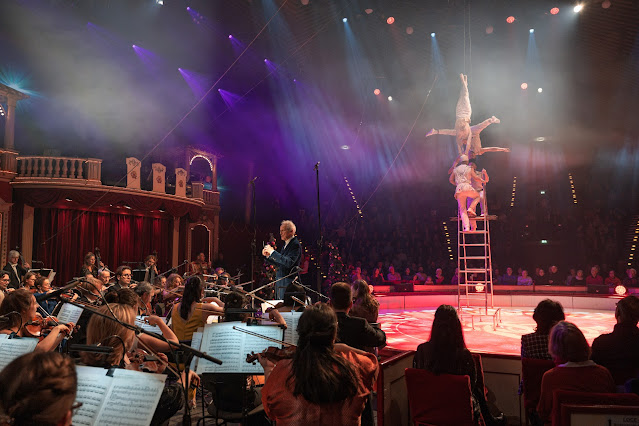 |
| Silvesterkonzert – Artists of Circus Roncalli, Deutsches Symphonie-Orchester Berlin conducted by Paul Daniel – Tempodrom, Berlin (Photo: Peter Adamik) |
Torsten Rasch: Pataphor; Beethoven: Symphony no.9 in D minor; Mirjam Mesak, Emily D’Angelo, Christopher Sokolowski, Christof Fischesser, Rundfunkchor Berlin, Rundfunk-Sinfonieorchester Berlin, Vladimir Jurowski; Konzerthaus am Gendarmenmarkt, Berlin.
New Year’s Eve concert (Silvesterkonzert): Artists of Circus Roncalli, Stephan Mörth, Thomas Holzmann, Deutsches Symphonie-Orchester Berlin, Paul Daniel; Tempodrom, Berlin.
New Year’s Day concert (Neujahrskonzert): Mendelssohn: Paulus; Johanna Winkel, Anke Vondung, Patrick Grahl, Samuel Hasselhorn; RIAS Kammerchor Berlin, Akademie für Alte Musik Berlin. Florian Helgath; Philharmonie Berlin.
Reviewed by Tony Cooper (30 & 31 December 2024, 1 January 2025)
Our roving European correspondent, Tony Cooper, travels to Berlin, a European capital he greatly favours, to see the Old Year out and ring in the New taking in a trio of concerts heard over consecutive days
My New Year’s cultural break in Berlin started in the historic Konzerthaus am Gendarmenmarkt offering a delightful concert from Rundfunk-Sinfonieorchester Berlin comprising Beethoven’s Choral Symphony heard against an illuminating new work by Torsten Rasch entitled Pataphor. And to punctuate New Year’s Eve, artists of Circus Roncalli joined forces with Deutsches Symphonie-Orchester Berlin to produce a dazzling, fun and entertaining concert at the Tempodrom while New Year’s Day witnessed a powerful and rewarding performance of Mendelssohn’s oratorio, Paulus, at the Philharmonie, Berlin.
To ease me out of the Old Year and launch me into the New, a trio of concerts in Berlin proved just the ticket with the first call falling to a New Year’s Eve pre-concert held at the magnificent and historic Konzerthaus am Gendarmenmarkt, Berlin, featuring Torsten Rasch’s Pataphor and Beethoven’s Symphony no.9 in D minor ‘Choral’ featuring soprano Mirjam Mesak, mezzo-soprano, Emily D’Angelo, tenor Christopher Sokolowski and bass Christof Fischesser with the Rundfunkchor Berlin and the Rundfunk-Sinfonieorchester Berlin conducted by Vladimir Jurowski.
The New Year’s Eve concert (Silvesterkonzert) at the Tempodrom, Berlin, witnessed artists of Circus Roncalli joining forces with the Deutsches Symphonie-Orchester Berlin conducted by Paul Daniel.
And on New Year’s Day, Mendelssohn’s Paulus, a work I’ve longed to hear for years and years, unexpectedly fell into my lap. A refreshing and beautiful oratorio, the performance featured soprano Johanna Winkel, mezzo-soprano Anke Vondung, tenor Patrick Grahl and baritone Samuel Hasselhorn with RIAS Kammerchor Berlin and the Akademie für Alte Musik Berlin conducted by Florian Helgath.
An illuminating and enlightened composer, Torsten Rasch (born Dresden 1965) he took piano lessons at the age of six and from 1974-82 was a member of Dresden’s renowned Kreuzchor before going on to study composition and piano at the city’s Carl Maria von Weber University.
He delivered a brand-new and exciting work entitled Pataphor (the word means an extended metaphor that goes beyond mere comparison to create a deeper, often absurd or surreal connection between two seemingly unrelated things) to open Vladimir Jurowski’s concert at the Konzerthaus am Gendarmenmarkt situated just off Unter den Linden, a jewel in Berlin’s magnificent architectural crown.
As an aside, the Gendarmenmarkt, created at the end of the 17th century by Johann Arnold Nering as a marketplace for the Linden Markt, derives its name from the Regiment Gens d’Armes. The most conspicuous building in the square, the Konzerthaus, is graciously flanked by the imposing neo-classical-designed French and German cathedrals while a statue of Germany’s most famous playwright, poet and philosopher, Friedrich Schiller, proudly stands in the centre.
But like most of Berlin’s historic sites Gendarmenmarkt has had a very chequered history. For instance, the Konzerthaus was built on the ruins of the National Theatre designed by Karl Friedrich Schinkel, one of Berlin’s most distinguished architects, who was also responsible for the reconstruction of the Berliner Dom, the equivalent of St Paul’s Cathedral. He redesigned it for the new Schauspielhaus and theatre duly opened in the summer of 1821 hosting the première of Carl Maria von Weber’s romantic opera, Der Freischütz.
However, if Beethoven was deemed a pioneering and free-thinking composer, the same, I feel, could be said of Torsten Rasch. For instance, he has worked with the likes of German industrial metal-band, Rammstein, on their ground-breaking, innovative 2002 work, Mein Herz brennt (My Heart burns), a 65-minute song-cycle commissioned by the Dresdner Sinfoniker and based on music/lyrics penned by members of the German band Rammstein.
ll received by audiences in Dresden and Berlin, a Deutsche Grammophon recording, which was awarded Best World Première Recording at the Echo Classical Awards in 2006, followed featuring René Pape, Katharina Thalbach and the Dresdner Sinfoniker conducted by John Carewe. In May 2009, the London Philharmonic Orchestra under Vladimir Jurowski successfully performed Mein Herz brennt in London.
Forward-thinking, too, Rasch has also collaborated with the London-based synth-pop duo, Pet Shop Boys (Neil Tennant and Chris Lowe) on a soundtrack for Sergey Eisenstein’s classic silent film of 1925, The Battleship Potemkin, commissioned by London’s ICA in 2006. The work sparked a great deal of interest in Rasch’s music especially after it received a ‘live’ screened showing in Trafalgar Square. And in the same year, the BBC jumped in with a commission for the Cheltenham Festival.
Work came flooding his way and one notable commission that had clout came from the Three Choirs Festival who invited Rasch to write a choral work to mark the centenary of the First World War. He duly delivered a well-constructed 40-minute cantata entitled A Foreign Field, a thought-provoking piece merging Latin texts with poetry written by the Dymock poets (a literary group of the early 20th century who made their homes near the village of Dymock in Gloucestershire) along with works penned by Austro-German poets, Georg Trakl and Rainer Maria Rilke.
Bringing together an impressive array of artists headed by the South Korean-born soprano Yeree Suh and the well-loved London-born baritone Roderick Williams, A Foreign Field (which takes its name from Rupert Brooke’s well-known poem, The Soldier) also included the choristers of Worcester, Hereford, Gloucester and Chemnitz cathedrals as well as the Three Choirs Festival Chorus. The work premièred in Worcester Cathedral in July 2014 featuring the Philharmonia Orchestra under the baton of Baldur Brönnimann with the German première taking place in Chemnitz a year later.
Rasch’s first foray into opera, though, came about with Rotter based on a play by East German dissident, Thomas Brasch, the scenario describing a man who tapped into the electric current of history only to be disconnected. Commissioned by Köln Opera, Rotter received its world première in February 2008 while a short orchestral work, Excantare fruges, premièred by the Dresdner Sinfoniker under Olari Elts, duly followed.
A big orchestral showpiece by Rasch emerged with Wouivres (a Celtic expression of several meanings) commissioned by the London Philharmonic Orchestra which found great favour and instant success at its world première in Chemnitz in October 2011 performed by the Robert Schumann Philharmonie Chemnitz under Frank Beermann.
Come 2009, the Two Moors Festival (Dartmoor and Exmoor) commissioned a couple of works from Rasch: a setting of Oskar Kokoschka’s poem Die Traumenden Knaben for the Pierrot Ensemble and a string quartet (the composer’s first) written for the Kuss Quartet and commissioned by Andreas Haefliger. The inspiration for the work came from Fra Angelico’s painting ‘Noli me tangere’ (‘Touch me not’), a phrase, according to St John, spoken by Jesus to Mary Magdalene when she recognised Him after His resurrection.
A year later, Rasch’s groundbreaking second opera, The Duchess of Malfi, came along. Based on the Jacobean revenge tragedy of John Webster’s play of the same name it was commissioned by English National Opera and the experimental theatre group Punchdrunk contributing so much to ENO’s Audience Development Award from the Royal Philharmonic Society in 2011.
Featuring German-born contralto, Claudia Huckle, as the Duchess, the opera, directed by Felix Barrett, founder/artistic director of Punchdrunk, received its première, of course, at the London Coliseum and was revived by Chemnitz Opera in 2013 while in the same year the song-cycle, Le Serpent Rouge, a BBC commission, was premièred by soprano Yeree Suh and the BBC Symphony Orchestra under André de Ridder.
A host of distinguished performers have engaged in Raush’s work such as baritone Wolfgang Holzmair and cellist Sonia Wieder-Atherton who premièred I see Phantoms at London’s Wigmore Hall in 2012 and in September of the same year Rasch’s Mendelssohn Lieder orchestrations were performed by Matthias Goerne and the Neues Bachisches Collegium Musicum in Leipzig while 2014 saw …in der Hülse von Schnee… a choral work based on the writings of the German poet and philosopher, Friedrich Hölderlin, performed at the Kammermusiksaal (Philharmonie Berlin) by the RIAS Kammerchor conducted by Hans-Christoph Rademann.
Getting up to speed, Rasch’s 100-minute music-theatre piece in ten scenes Die andere Frau (The Other Woman) commissioned by Dresden Semperoper with a libretto by Helmut Krausser, based on the biblical story of Abram and his wife Sarai, received its première in January 2022. The scenario focuses on the love triangle of the surrogate mother, Hagar, who’s cast out after the birth of Sarai’s son, Isaac.
The biblical story represents the emergence of the three monotheistic world religions: war and peace; loss of home; love and tolerance. Rasch included in the work early Babylonian text fragments while opening a window into a completely different musical culture with passages written for the Iranian-born singer, Sussan Deyhim.
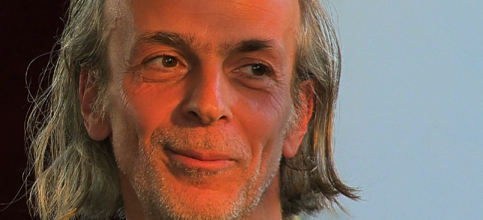 |
| Torsten Rasch (Photo from his website) |
However, stuck in the present, Torsten Rasch’s new work, Pataphor (lasting a mere 12 minutes) proved an astonishing and spirited piece of writing that made full use of the fine and talented bunch of musicians who make up the Rundfunk-Sinfonieorchester Berlin who, under the baton of Vladimir Jurowski, played so magnificently.
An energetic and exciting rush of timpani opens the work followed by woodwind, most notably flutes, bubbling away in a sea of musical adventure whilst a burst of energy amplifies itself by some incredibly high playing from the violins heard against a handful of staccato bass trombone bars punctuated by a generous sway of percussive sounds seemingly coming from all over the show.
And if keeping something up his sleeve, Rasch offers an exciting ending that really hit the mark from my perspective by firing up the work with a run of syncopated jazz-related symphonic bars utilising a xylophone while the brass blazed a high-note trail not too dissimilar to Stan Kenton’s Wall of Sound.
I found Pataphor such an interesting and exciting piece. A brilliant and immersive work, I sincerely hope that other leading orchestras of the world take it into their repertoire.
Looking ahead, Rasch’s new music-theatre piece, Die wunderbaren Jahre (The Wonderful Years), commissioned by Theater Regensburg, features three singers, a narrator and a chamber ensemble with the scenario (after the book by Reiner Kunze) examining the everyday life of young people in the DDR. That’s something to look forward to. I hope to be a member of the audience.
Over the years, decades really, I’ve enjoyed many concerts in the Konzerthaus am Gendarmenmarkt and I just wonder how many times Beethoven’s ‘Choral’ symphony (commissioned by the Philharmonic Society of London in 1817) has been performed within its hallowed walls. Lots, I should imagine!
However, this grand performance of Beethoven’s mighty, joyous and uplifting work by Rundfunk-Sinfonieorchester Berlin and the Rundfunkchor Berlin under the baton of Vladimir Jurowski would take some beating. And how well the Rundfunkchor – regimentally lined above the orchestra with female and male voices in situ either side of the organ console with the soloists in the middle – effortlessly and joyously sang.
The anticipation of the fourth and last movement is, of course, eagerly awaited but the ensuing three movements leading up Beethoven’s Big Sing offer so much to the listener. For instance, the opening bars of the first movement showed the delicate side of Beethoven’s writing while the last movement offers so much following the soft and controlled playing of the ‘adagio’ introducing the spiritual, serene, hymn-like rendition of the ‘Ode to Joy’ theme symbolizing hope, unity and fellowship delicately and sensitively performed by the double-bass section while building up to the powerful ‘choral’ part that’s everybody’s favourite!
The quartet of soloists comprising Estonian-born soprano Mirjam Mesak, Canadian-born mezzo-soprano Emily D’Angelo, American-born tenor Christopher Sokolowski and especially the German-born bass Christof Fischesser – were found on sparkling form.
The ‘Choral’ is a team effort to say the least and everybody played their part to the full and did the work justice. At curtain-call, the packed house of the Konzerthaus offered their approval of such a fine performance by wave upon wave of thunderous applause that truly stamped the credentials on Beethoven’s lasting masterpiece which reaches out to so many people and widely regarded as one of the supreme achievements in the history of music.
But fast rewind to Christmas Day 1989, the packed house at the Konzerthaus I bet was buzzing with excitement, too, when Leonard Bernstein took to the podium to conduct the ‘Choral’ with ‘Freiheit’ (Freedom) replacing ‘Freude’ (Joy) in a performance to celebrate the Fall of the Berlin Wall.
Musical forces taking part included the Bavarian Radio Symphony Orchestra and Chorus, the Chorus of the Berlin Radio Symphony Orchestra and members of the Sächsische Staatskapelle Dresden and the Philharmonischer Kinderchor Dresden as well as members of the Kirov Theatre Orchestra, London Symphony Orchestra, New York Philharmonic and Orchestre de Paris. The quartet of soloists comprised soprano June Anderson, mezzo-soprano Sarah Walker, tenor Klaus König and bass Jan-Hendrik Rootering.
Bernstein conducted the ‘Choral’ one last time with soloists soprano Lucia Popp, mezzo-soprano Ute Trekel-Burckhardt, tenor Wiesław Ochman and bass Sergej Kopčák at the Prague Spring Festival with the Czech Philharmonic and Prague Philharmonic Choir in June 1990. He died four months later.
The text, of course, for the fourth (and last movement) is adapted from ‘An die Freude’ (‘Ode to Joy’), a poem written by Friedrich Schiller in 1785 and revised in 1803 with additional text by Beethoven. In the 20th century, an instrumental arrangement of the chorus was adopted by the Council of Europe (now the European Union) as the ‘Anthem of Europe’.
Composed between 1822 and 1824, the ‘Choral’ successfully received its world première in Vienna at Theater am Kärntnertor on 7 May 1824 with the likes of Franz Schubert, Carl Czerny and the Austrian chancellor, Klemens von Metternich, in the audience.
Promoted by the Gesellschaft der Musikfreunde (Society of Friends of Music in Vienna) founded in 1812 by Beethoven’s friend, Joseph Sonnleithner, the performers comprised the house orchestra of the Kärntnertor with soprano Henriette Sontag, mezzo-soprano Caroline Unger, tenor Anton Haizinger and bass Joseph Seipelt. The concert, however, opened with the overture Die Weihe des Hauses (The Consecration of the House) followed by three parts of the Missa solemnis (Kyrie, Credo and Agnus Dei).
Incidentally, the British première of the ‘Choral’ took place on 21 March 1825 at the Argyll Rooms conducted by Sir George Smart with the choral part sung in Italian. Incidentally, the ‘Argyll’ was situated on Little Argyll Street off Regent Street, the home of the Philharmonic Society of London from its inception in 1813 until 1830, where Spohr, Liszt and Mendelssohn made their first appearances in England.
Interestingly, Richard Wagner inaugurated the Bayreuth Festival by conducting the ‘Choral’ on 13 August 1876 while Wilhelm Furtwängler conducted it with the Bayreuth Festival Orchestra at the festival’s post-war reopening in 1951. Subsequently, the symphony has been performed in Bayreuth in 1953, 1954, 1963 and 2001. A performance was planned for the 2020 Bayreuth season but cancelled because of the Covid pandemic. However, the ‘Choral’ will be heard once again in Bayreuth’s famed Festspielhaus in 2026 in celebration of the 150th anniversary of the Bayreuth Festival.
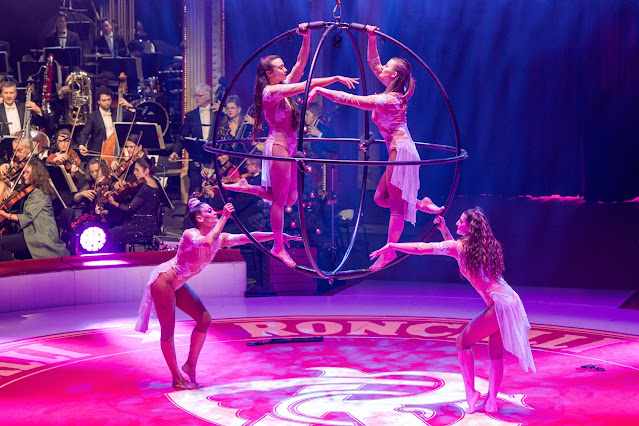 |
| Silvesterkonzert – Artists of Circus Roncalli, Deutsches Symphonie-Orchester Berlin conducted by Paul Daniel – Tempodrom, Berlin (Photo: Peter Adamik) |
However, in stark contrast to my thought-provoking New Year’s Eve concert, my New Year’s Day affair was something completely different to say the least finding me soaking up a potpourri of music and circus all wrapped up in one big festive parcel of discovery and magic courtesy of Deutsches Symphonie-Orchester Berlin and Circus Roncalli, a seasonal highlight of Berlin’s cultural calendar since 2004.
Held in the 3500-seater circular auditorium, the Tempodrom, close by to Potsdamer Platz and the Brandenburg Gate, the show, a rip-roaring success, may I add, offered a symbiosis of symphonic beauty and glittering elegance coupled with a host of sensational circus acts while clarinettists Stephan Mörth and Thomas Holzmann grabbed the audience’s attention when they entered the ring to play their party pieces.
Overall, there were 17 items on the playlist which opened in a grand and imposing manner with a fine rendering of Korngold’s overture to the 1939 American historical romantic film, The Private Lives of Elizabeth and Essex, directed by Michael Curtiz and starring Bette Davis, Errol Flynn and Olivia de Havilland fictionalizing the historical relationship between Queen Elizabeth I and Robert Devereux, 2nd Earl of Essex. A perfect ‘opener’ to the show fusing the art of classical music with the art of circus with the members of DSO under Paul Daniel found on great form.
The show took off circus wise, though, with the Sky Circus Troupe, founded in Ulaanbaatar, capital of Mongolia, in 2012, who offered speed, precision and concentration in their all-encompassing gymnastic display which was absolutely sensational, fast-paced and appropriately performed to John Adams’ Short Ride in a Fast Machine.
In stark contrast and slowing down the action, the delicate and fine clowning deuce, Oriol and Gensi, the latter dressed as Pierrot, the white clown, pranced around the ring performing a host of novelty duets but one that ticked my box was their offering of a tuneful and catchy tune effectively utilising a small party balloon and a concertina.
A musical upgrade came by way of Gustav Holst’s The Planets (‘Mars’ and ‘Jupiter’) propelling the performance of the Serbat Troupe’s chairs-and-stairs balancing act while John Williams’ Theme from Jurassic Park accompanied Duo Shum’s Cyr Wheel display. A wonderful couple they were elegantly attired in long-flowing white garments and equally elegant spinning round the ring in an effortless, high-calibre acrobatic performance.
By and large circus is a family business and Lili Paul-Roncalli, who has appeared at the famous Dresden Opera Ball, the youngest child of the Austrian circus director and co-founder of Circus Roncalli Bernhard Paul and the Italian artist, Eliana Larible-Paul, keeps the family flag flying in the ring. She offered the show a sensational contortionist act admirably and dramatically performed to ‘Seguedille’, ‘Aragonaise’ and ‘Les toreadors’ from Bizet’s ever-popular opera, Carmen.
And the ‘adagio’ from Rachmaninov’s second symphony found great favour with the audience and contributed so much to Duo Turkeev’s aerial act of precision and total commitment to their artform while Liazeeds Roses, comprising a team of four absolutely radiant-looking girls, took to the heights of the Tempodrom performing in true balletic style to Dvořák’s Slavonic Dance No.2 in E minor while Geraldine Philadelphia reached out to the 19th-century Austrian-born composer, Joseph Hellmesberger, using his invigorating and upbeat piece Devil’s Dance for her energetic and upbeat hoop juggling act.
Catch a fallen star, put it in your pocket! Extraordinary and talented star-catcher, Daniel Rosenfeldt, did just that. Juggling in his own distinctive, hypnotic and mindful way, he controlled a host of luminous-white balls freely flying all over the show to Hans Zimmer’s Run Free written for the movie, Spirit – The Wild Mustang.
But one attraction that really grabbed my attention and one that I enjoyed so much fell to Oliver Polak, a first-class showman harbouring so much theatrical charm and charisma, who appropriately set his magical flower act to the ‘Waltz of the Flowers’ from Tchaikovsky’s The Nutcracker.
A voluminous act, of course, bunch upon bunch of brightly-coloured spring-feathered flowers sprung out of a box that seemed too small to contain them with the pièce de résistance of the show coming from a pretty girl with a pretty flower-printed dress arriving just in the nick of time to end the act on a sensational high to mammoth applause from a bamboozled and bewildered audience. Where did she come from? That’s the secret!
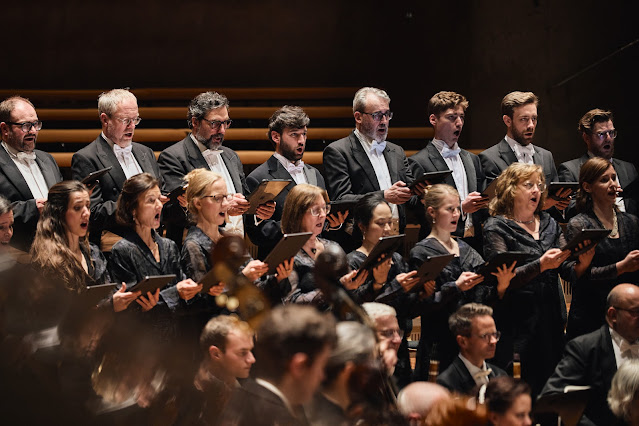 |
| Neujahrskonzert: Mendelssohn: Paulus – RIAS Kammerchor Berlin, Akademie für Alte Musik Berlin conducted by Florian Helgath; Philharmonie Berlin (Photo: Fabian Schellhorn) |
A work I’ve longed to hear for years and years, Paulus, Mendelssohn’s first oratorio, is not often performed in the UK nowadays but gives way to his great and inspiring two-part choral masterpiece, Elijah. And this monumental and well-loved work received its first performance in England on Wednesday 26 August in the newly built Birmingham Town Hall to a 2,500-strong audience. .
Conducted by the composer, the performance was, by all accounts, triumphant and formed part of the 1846 Birmingham Triennial Festival who, incidentally, shared their festival with Leeds and Norwich while the other Triennial, the Three Choirs Festival, rotates to this very day with the cathedral towns of Hereford, Gloucester and Worcester.
A couple of years later Elijah was heard at the Norfolk & Norwich Triennial Festival in St Andrew’s Hall proving a ‘winner’ all the way and becoming the city’s most popular work receiving no fewer than 13 performances from its first Norwich outing leading up to 1930. On the other hand, St Paul, I discovered diving into the Triennial archives, received its first performance at St Andrew’s Hall in 1881 followed by a further performance in 1893. And that was it, I’m afraid.
The libretto fell to Julius Schubring (also librettist of Elijah), a childhood friend of Mendelssohn and pastor of St John’s Church, Dessau. Most of the passages derive from the New Testament (Acts of the Apostles) as well as texts of chorales and hymns in a manner after Bach’s model. Composition started in 1834 and was completed in early 1836 with the work receiving its world première on 22 May 1836 in the Tonhalle, Düsseldorf. The occasion marked the 18th edition of the Lower Rhenish Music Festival.
Mendelssohn also conducted the first performance of Paulus to be heard in Leipzig in the Paulinerkirche on 16 March 1837 and then duly revised the work and in this final version it was performed in English as St Paul receiving its UK première on 3 October 1836 in Liverpool in a translation by Mendelssohn’s bosom friend, Karl Klingermann.
However, following the Düsseldorf première of Paulus, Mendelssohn travelled to Frankfurt to take the podium from the seriously ill conductor, Johann Niklaus Schelble, who, in fact, commissioned the oratorio, for a performance by the celebrated Cäcilienchor (founded in 1818) in Frankfurt’s Cäcilienverein on 4 May 1836.
During performance a very young and attractive member of the soprano section of the chorus, Cécile Charlotte Sophie Jeanrenaud, caught, as if by magic, Mendelssohn’s eye. She was the youngest daughter of the French Huguenot minister August Jeanrenaud and his wife Elisabeth Wilhelmine Jeanrenaud, née Souchay de la Duboissière. The magic worked and the couple duly became engaged in September 1836 tying the knot on 28 March 1837 ten months after the first performance of Paulus. The couple had five children: Carl, Marie, Paul, Lili and Felix August.
In fact, Mendelssohn was closely associated with the Cäcilienchor (named, of course, after the patron saint of music whose day falls on 22 November and is, indeed, Britten’s birthday) acting as its musical director for many years while conducting them in historical performances of Bach’s St Matthew Passion (1829) and the B minor Mass (1833), works the young and enthusiastic Mendelssohn had discovered after they had fallen into oblivion following the Bach’s death in 1750. As a token of his admiration for the Cäcilienchor (who also gave the first performance of the Christmas Oratorio in Frankfurt in 1858) Mendelssohn dedicated several of his compositions to the choir including that of Paulus.
Inescapably influenced by Beethoven (I guess all Romantic composers were), Mendelssohn wrote, though, in a combination of classical and romantic styles. He was terribly fond of Bach therefore in Paulus’ quite lengthy overture (later heard as a chorale) it incorporates to good effect Bach’s Lutheran setting of the well-loved chorale ‘Wachet auf! ruft uns die stimme’ (Awake, calls the voice to us) composed in 1731 for the 27th Sunday after Trinity. In fact, Paulus is modelled on similar lines to the magnificent choral works penned by Handel and Haydn while a host of recitatives, arias and chorales clearly punctuate the mighty and glorious Passion settings by Bach.
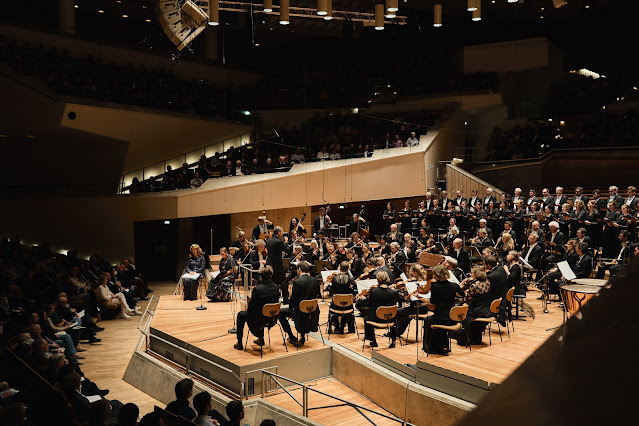 |
| Neujahrskonzert: Mendelssohn: Paulus – RIAS Kammerchor Berlin, Akademie für Alte Musik Berlin conducted by Florian Helgath; Philharmonie Berlin (Photo: Fabian Schellhorn) |
Divided into two parts Paulus offers 45 items performed over six telling scenes (Stoning of Stephen; Conversion and baptism of Saul (Paul); Mission of Paul and Barnabas; Persecution of Paul by his former fellow believers; Farewell of Paul from Ephesus; Martyrdom of Paul) describing the development of Saul (of Tarsus) to the apostle Paul.
Therefore, the first part describes Saul, a Pharisee, who persecuted followers of Christ, for instance, the martyrdom of St Stephen by stoning and Saul’s persecution of Christians while the well-known arioso ‘But the Lord is mindful of His own’ foretells the miracle of Paul’s conversion to Christianity when travelling the road to Damascus from Jerusalem. This pivotal scene is followed by the conversion of Paul, his baptism and ordination as a minister by Ananias.
The second part opens in a gently flowing and relaxed manner witnessing Paul and Barnabas becoming ambassadors of the Church punctuated by one of the best-loved choruses of the entire oratorio ‘How lovely are the messengers’ while other distinctive passages depict the Jews attempted entrapment of Paul, the miraculous healing of a crippled man at Lystra and Paul’s farewell following his missionary work in Ephesus onward by boat to new adventures in Jerusalem.
Throughout the work, the chorus comprising the ultra-professional RIAS Kammerchor and a polished German front-line of soloists comprising soprano Johanna Winkel, mezzo-soprano Anke Vondung, tenor Patrick Grahl and baritone Samuel Hasselhorn comment upon the story at every conceivable turn while the women’s chorus vividly representing the voice of Jesus in the recitative and chorus ‘Saul, why do you persecute me?’ was handsomely sung. Other parts of the Scriptures are included within the work by passages taken from Timothy, Isaiah and St John’s Gospel.
Under German-born conductor, Florian Helgath, a former chorister of the Regensburger Domspatzen, the Akademie für Alte Musik Berlin (Akamus), founded in 1982, played so magnificently. I can clearly see after this brilliant performance of Paulus why Akamus has become recognised as one of the world’s leading period chamber ensembles.
The performance in the Philharmonie Berlin offered me so much not least by the fact that it fortified my Christian beliefs and refreshed my inner spirit but also proved a most fitting start to the New Year.
The last word, however, goes to Robert Schumann who affectionally wrote of Paulus: ‘Here you’ll be inspired to faith and hope and learn to love your people again. Paulus is a work of the purest kind – one of peace and love.’ I couldn’t agree more.
New Year’s Eve pre-concert (30 December): Torsten Rasch’s Pataphor; Beethoven’s Symphony no.9 in D minor (‘Choral’); Mirjam Mesak (soprano), Emily D’Angelo (mezzo-soprano), Christopher Sokolowski (tenor), Christof Fischesser (bass), Rundfunkchor Berlin, Benjamin Hartmann (chorus master), Rundfunk-Sinfonieorchester Berlin conducted by Vladimir Jurowski; Konzerthaus am Gendarmenmarkt, Berlin.
New Year’s Eve concert (Silvesterkonzert): Artists of Circus Roncalli, Stephan Mörth (clarinet), Thomas Holzmann (clarinet), Deutsches Symphonie-Orchester Berlin conducted by Paul Daniel; Tempodrom, Berlin.
New Year’s Day concert (Neujahrskonzert): Mendelssohn’s Paulus: Johanna Winkel (soprano), Anke Vondung (mezzo-soprano), Patrick Grahl (tenor), Samuel Hasselhorn (baritone); RIAS Kammerchor Berlin, Akademie für Alte Musik Berlin conducted by Florian Helgath; Philharmonie Berlin.
The blog is free, but I’d be delighted if you were to show your appreciation by buying me a coffee.
Elsewhere on this blog
- 2024 in record reviews: white-hot prophets, sensitive souls, a German in Venice, Holst’s organ and the 20th century brass band – article
- 2024 – A year in concert reviews: astonishing youth, late-romantic rarities, riveting symphonic theatre – article
- 2024 – A year in opera reviews: strong individual performances, reinventing classics and historically informed Wagner – article
- Modern aspects of the Christmas story: Gabriel Jackson’s The Christmas Story and Edward Nesbit’s Nativity – record review
- The Dunedin Consort at Wigmore Hall: Caroline Shaw premiered alongside rare Stradella and Christmas Corelli – concert review
- Vivid engagement, vigorous articulation & imaginative programming: The English Concert at Wigmore Hall – concert review
- Opera Up-Close: Unveiling the dramatic process with Paul Curran & young artists of Palm Beach Opera, our latest Letter from Florida
- The songs of Robert Kahn: Florian Störtz & Aleksandra Myslek reveal some of the gems to be found in the output of a relatively forgotten composer forced into exile by the Nazis – concert review
- Satisfying, yet thought-provoking: Handel’s Messiah from Laurence Cummings and the Academy of Ancient Music – concert review
- He would stop writing if there was no-one to perform his music: for composer Stephen Goss’ his latest triple album is all about a celebration of collaboration – interview
- Mad, magical and mesmerising: Tom Coult’s Pieces that Disappear, his debut disc from NMC Records – record review
- Home



